
Le counte del MONTE, d'argent, a un lion rampant de goules a la cowe croyse, corone d'or, a une labeu dazur--Roll, temp. HEN. III.The same varieties are found in the tails of other animals than Lions, but not so frequently, e.g.
De sable, au lion d'argent, armé, lampassé, et couronné d'or; la queue fourchue, nouée, et passée en sautoir--BOURNONVILLE, Champagne.
De gueules, a deux lions adossés et passés en sautoir d'or; les queues en double sautoir--FOSSEZ de COYOLLES, Valois.
Argent, a lion rampant double tailed gules, one of the tails coward--WALLIS.
Sable, a bull statant argent, the tail between his legs[i.e. coward]--FITZ-GEFFREY, co. Bedford.
Ermine, a griffin segreant coward gules, beaked and legged azure--GRANTHAM, co. Lincoln.
Argent, two bars sable, on the upper one a wivern volant, tail extended of the field--MANFELD.
 |
| CORKE. |
Sable, three lion's tails erected and erased argent--CORKE, Cornwall.Different names have been fancifully given by some heralds to the tails of different animals, such as the single, the wreath, the scut, &c., but no instances have been observed of their use.
Argent, a chevron gules between three beaver's tails erect proper--LEWES, co. Kent.
Argent, three lion's tails double queued erect sable--PINCHBECK.
Or, on a mount gules three lion's tails erect of the second, tails turned to the sinister--TAYLARD.
Argent, on a mount vert a representation of the 'forty-feet reflecting telescope' with its apparatus proper, a chief azure, thereon the astronomical symbol of 'Uranus' or 'Georgium Sidus' irradiated or--HERSCHEL, co. Bucks; Baronetcy, 1838.Templars. See Knights Templars.
Argent, on a mount in base vert an antique temple of three stories, each embattled; from the second battlement two steeples, and from the top, one, each ending in a cross sable--TEMPLAR, [granted 1765].Tenants, (fr.). See Supporters.
Quarterly azure and gules, the perspective of an antique temple argent, on the pinnacle and exterior battlements a cross or; in the first quarter an eagle displayed; in the second a stag trippant regardant of the last--TEMPLER, co. Devon.
Azure, a temple or--TEMPLE, Scotland.
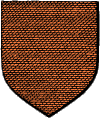 |
| Tenné. |
Argent, a maunch tenne--TICKELL.
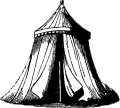 |
| Tent. |
Argent, a chevron between three royal tents sable--TINTEN, St.Fudy, Cornwall.In French arms a Pavilion, or tent, was sometimes adopted for surrounding the shield-especially the Royal shield-instead of the Lambrequin or Mantle. For one form also the term Capeline seems to be used.
Azure, a chevron between three tents argent--MAYBANK.
Sable, three pavilions argent, lined ermine--Company of UPHOLDERS' Chester.
Sable, three pavilions[or spervers] ermine, lined azure, garnished or; within the pavilion in base a lamb couchant argent, on a cushion or tasselled of the last; over the head a cross fitchy gules, [Elsewhere blazoned Sable, on a chevron or, between three tents without poles, ermine, lined azure(another, 1730, gules); as many roses gules]--Company of UPHOLDERS, granted 1465.
 |
| Thistle. |
 |
| Badge of the STUARTS. |
Per pale azure and gules three lions rampant argent; a chief per pale or and argent, charged on the dexter side with a rose gules, and on the sinister with a thistle vert--PEMBROKE COLLEGE, Oxford, founded 1620.
Azure, on a fesse argent between a thistle in chief or and a trefoil in base of the second a cinquefoil gules--STEERS, Ireland.
Gules, a crosier or and sword argent saltirewise; on a chief of the second a thistle vert--KIRK, Scotland.
Argent, a lion passant gardant gules gorged with an open crown and crowned with an imperial one proper, holding in the dexter paw a sword of the last defending the thistle placed in the dexter chief point vert, ensigned with a crown or--OGILVIE, co. Kincardine.
Gules, a bend engrailed argent, in chief a thistle leaved or--GEMMILL, Scotland.
Or, a fesse azure between three thistles slipped vert, flowered gules--Miles SALLEY, Bp. of Llandaff, 1500-16.
A thistle slipped and leaved, ensigned with the imperial crown, all proper--Badge of SCOTLAND; [it occurs also amongst the badges of the STUARTS].
D'azur, a trois chardons d'or--De CARDON, Lorraine et Artois.
Argent, on a fesse gules three oval buckles or; in base three thistle-leaves conjoined vert--LESLIE, co. Monagham.
 |
| Teazel. |
Argent, a chevron sable between three teazels stalked and leaved proper--FULHAM.Thistle, Order of the. See under Knights.
Argent, three teazels slipped proper--BOWDEN.
 |
| Crown of thorns. |
Argent, a cross Tau gules, in chief three crowns of thorns vert--TAUKE, Sussex.Three, two, and one; a term often used in blazon, q.v., to shew the position of six charges.
Azure, a crown of thorns or, between three saltires or--See of CAITHNESS, Scotland.
Azure, a lozenge throughout or, charged with a crescent gules--PRAED.
Baudewin de FRIVILLE de veyr a une croyz passant de goules--Roll, temp. HEN. III.
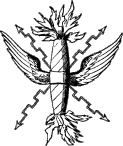 |
| Jupiter's thunderbolt. |
Azure, Jupiter's thunderbolt or, shafted and winged argent--TOMYRIS.
Azure, a chevron between three escutcheons or, on each a thunderbolt chased--EDMONDS.
Azure, a sun between three thunderbolts winged and shafted or--STRICKSON, granted June 14, 1707.
 |
| Tiara with rays. |
Azure, three clouds proper, rays issuing therefrom downwards or, surmounted by as many tiaras[or triple crowned], the caps gules, the crowns gold--DRAPERS' Company, London; granted 1439.Tierce, (fr.): a charge occurring in some French arms, consisting of three triangles arranged generally in fesse. There may be two tierces in the same shield.
 |
| LOVE. |
Vert, a heraldic tiger[possibly a wolf, i.e. loup] passant or mane and tuft of the tail argent--LOVE, co. Norfolk; granted 1663.Tilting-spear. See Spear.
Argent, a tiger rampant collared and chained or--O'HALIE.
Or, a tiger passant gules--LUTWYCHE, Salop.
Gules, a chevron argent, between three tigers, regardant[into mirrors] of the second--BUTLER of Calais.
Per fesse ermine and sable a heraldic tiger argent, in chief two mascles of the second--DANIELS, Lymington, co. Hants.
Vert, within two bars ermine between two heraldic tigers passant, one in chief and one in base or, three garbs of the last--MINTON, Stoke-upon-Trent, co. Stafford.
Or, two bars gemel gules between three tiger's heads[otherwise boar's heads] sable, two and one--JENKINSON.
Sable, a lion rampant regardant argent, on a chief embattled or a sword erect proper, hilt and pomel gold, enfiled with an eastern crown gules, between two[natural] tiger's faces also proper--FLOYD.
Gules, a cross vert--DENHAM, Suffolk.Secondly, the rule does not extend to chiefs, cantons, and bordures, which, however, are in such cases by some heralds represented as cousu, i.e. giving the idea of the charge being sewed to, and not laid upon, the field. Marks of cadency also, such as labels, bendlets, and batons are exempt from the rule.
Barry of ten argent and azure, a lion rampant gules--STRATFORD, Gloucester.The fourth is, when charges are borne of their natural colour, not being one of the recognised tinctures of heraldry. (See Colours.) Such charges are nevertheless generally placed upon a field of a contrasted tincture.
Barry of ten or and gules, a lion rampant argent--STRATFORD, Coventry.
Per pale azure and gules, an oak-tree proper supported on the sinister side by a lion rampant argent--THOMAS, co. Hereford.
1. Or . . . . Gold . . . . Sun . . .. Topaz. 2. Argent . . . Silver . . . . Moon . .
. Pearl. 3. Gules . . . Red . . . . Mars . .
. Ruby. 4. Azure . . . Blue . . . . Jupiter .
. Sapphire. 5. Sable . . . Black . . . . Saturn . .
. Diamond. 6. Vert . . . Green . . . . Venus . .
. Emerald. 7. Purpure . . Purple . . . . Mercury .
. Amethyst. 8. Tenné . . . Tenny . . . . Dragon's Head . . . Hyacinth. 9. Sanguine . . Blood colour . Dragon's Tail . . . Sardonix.
Ermine. |Ermines. |Pean. |Vair. Erminois. |Erminites. |Meirri. |Verry.
Argent, on a mount in base vert three plants of tobacco growing and flowering all proper--Company of TOBACCO-PIPE MAKERS, London; incorporated 1663.Tobias. See Ararat.
Sable, five bezants in saltire; a chief indented argent, thereon three stalks of tobacco, each consisting of three leaves proper--CARDOZO; granted to Samuel Nunez Cardozo, Hackney, near London.
Argent, a tombstone gules--ALBON.Tongs. See Founders'.
Vert, three tombstones argent--TOMBS[represented as coped stones crossed].
Sable, three bars nebuly vert, in chief as many playing tops argent[otherwise, Sable, three bars vert; on a chief indented gules as many tops argent]--TOPP.Torch, (fr. flambeau), or fire-brand, is often borne raguled; and a Staff raguly flammant(q.v.) is practically the same.
Sable, on two bars argent three water-bougets vert, two and one; a chief gules charged with three playing tops of the second--TOPP.
Argent, three playing tops sable, two and one--ANVINE.
.... a chevron .... between three pegtops .... --TOPCLYFF, [in the church at Topcliffe, co. York, 1391].
Argent, three torches proper--COLAN.Torqued: bowed-embowed, especially of a serpent's tail; also wreathed.
Azure, three torches or, fired[or lighted] proper--COLLINS, Ottery S.Mary, co. Devon.
Azure, three fire-brands proper--COLLENS, Barnes Hill, co. Devon.
Argent, a fire-brand(or staff) with one ragule on each side, sable, and inflamed in three places proper--BILLETTES.
 |
| CAMOYS. |
Walter de BASCREVILE, argent, ung chevron et trois torteux de goules--Roll, temp. HEN. III.It is said in books that tortoilly may be used for semé of torteaux, but it has not been observed.
Hugh WAKE, d'or, a deulx barres de goules, ove trois torteux de goules en le cheif--Ibid.
Sire Hugh WAKE, de or, a ij barres de goules, en la chef iij rondels de goules, el un baston de azure--Roll, temp. ED. II.
Rauf de CAMOIS, d'or; ung cheif de goules a trois torteux d'argent--Roll, temp. HEN. III.
Rauf de CAMOYS, dor; al chef de goules a tres gastelles d'argent en chef--Ibid. [Harl MS. 6589].
Sire Rauf de CAMOYS, de or; od le chef goules a iij rondels de argent--Roll, temp. ED. II.
Le Sire de CAMOYS, port d'or, au cheif de gules, a trois pellets en le chief d'argent--Roll, temp. ED. III.
Argent, on a chief gules three plates--CAMOYS, Broadwater, Surrey.
Argent, a torteau between three escutcheons sable--LOUDON, Scotland.
Or, six torteaux, two, two, and two--WALSHALL.
Argent, three cups sable, a torteau[? for difference]--Richard GRENEACRES.
Argent, semy of torteaux; on a pile azure a lion rampant of the field--HENSLEY.Tortilly, (fr. tortillant): a term applied to Ordinaries which are wreathed, as shewn in the margin; the term wreathy is also found. The French apply the term tortil to the wreath or turban with which heads, and especially those of Moors, are adorned in heraldry. See Wreathed.
Sable fretty argent, on each crossing a torteau gules--EAGAR.
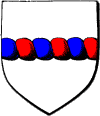 |
| CARMICHAEL. |
Argent, a fesse tortilly[or wreathed] azure and gules[otherwise, but not so well, a wreath in fesse throughout]--CARMICHAEL.
Argent, a cross wreathed gules and azure[otherwise, a fesse wreathed gules and azure, depressed by a pale wreathed as the fesse]--SERESBY.
Or, a lion rampant gules, a chief tortilly gules and vert charged on the first with a crescent argent between two mullets of the last in the second--MACRITCHIE, Edinburgh.
Argent, a bend tortilly azure and or--OARE, Sussex.
De gueules, au tortil d'argent--ZBONSKI DI PASSEBON, Provence.
 |
| GAWDY. |
Argent, a tortoise displayed, tergiant barwise[otherwise passant] vert--GAWDY, Norfolk.Tower, (fr. tour): towers and turrets are more frequently named in connection with the Castle(q.v.), but they are also found in some cases as distinct charges. Though a castle is sometimes represented as consisting of a single tower, it generally has at least three. The ordinary tower is drawn as the first example given in the margin.
Argent, on a cross azure between in dexter chief and sinister base a tortoise gradient vert five fleurs-de-lis of the first--LE NEVE, London.
Azure, a tortoise erect or--COOPER.
Vert, three tortoises haurient or--HARPENY.
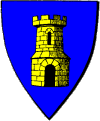 |
| TOWERS, Northampton. |
Azure, a tower or--TOWERS, Northampton.But the tower is also frequently represented as bearing three smaller towers or turrets, and then it is blazoned triple towered, or triple turretted: in that case it is drawn as the annexed figure in the margin, sometimes with the turrets slightly sloping outwards, sometimes upright. It is frequently described as having a dome or cupola, both terms being used for the same thing; and sometimes a spire or conical roof. Also as provided with a port or entrance, port-holes or windows, battlements, &c.
Gules, in chief a castle surmounted with a tower argent; in base a lion passant gardant or--City of NORWICH.
Sable, three high towers argent--DE TOUR, Shrewsbury.
Sable, a plate between three towers argent--WINSTON.
Argent, five towers, two, two and one gules--CORNELL.
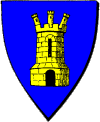 |
| TOWERS, Isle of Ely. |
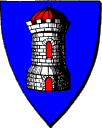 |
| DE LA TOUR. |
Azure, a tower triple-towered or--TOWERS, Isle of Ely.The term turret is sometimes used alone, separate from the tower, and can only be represented as a smaller tower. The terms tourelle and torele are also found.
Argent, on a mount vert a tower triple-towered sable--CHIVERTON, Lord Mayor of London, 1658.
Azure, a castle triple-towered argent, port-holes and gate gules--M'LEOD.
Azure, two lions rampant argent chained or, supporting a tower triple-turretted of the second--KELLY, Ireland.
A tower triple-turretted of the second--OWEN, co. Montgomery.
Azure, a tower[otherwise with a cupola] argent, embattled and domed, the port gules--Gilbert DE LA TOUR, Dorset.
Azure, on a mount vert a castle embattled with three towers domed, on each a pennon, all or--Town of CLITHEROW, Lancashire.
Azure, on a mount proper couped a castle triple-towered argent, the middle tower with dome and pennon--NIELSON, Bothwellshiels.
Gules, a four-square castle in perspective with as many towers and cupolas, one at each angle, argent, standing in water azure--RAWSON, co. York.
Azure, on a bend between two water-bougets or three leopard's faces gules; a chief as the last charged with a castle triple-towered argent, having from the centre tower of a pyramidical shape a banner displayed like the first--HUNT, Limerick.
Sable, a quadrangular tower with four towers in perspective argent, masoned proper; the base of the escutcheon water of the last--Town of PONTEFRACT, Yorkshire.
Gules, a triple circular tower in a pyramidal form or, the first with battlements mounted with cannon of the last, all within a bordure azure charged with eight towers domed or--Town of LAUNCESTON, co. Cornwall.
Azure, a square castle embattled above the gate and at the top, triple-towered, the central tower larger than the dexter and sinister; on each side the central tower a sentinel-house or watch-tower, which are with the three towers pyramidally roofed, all argent, masoned sable, the portcullis and windows gules; the middle tower ensigned with a staff and banner charged with Royal arms of Scotland--Burgh of FORFAR.
Le Roy de PORTUGAL, de goules poudre a turelles d'or a une labeu lazur--Roll, temp. HEN. III.Town, (fr. ville), or city: this device has been introduced occasionally into late coats of arms. An example of the city of NAKSIVAN will be observed under Ararat, and of ACRE under Sphinx. Examples more frequently occur in French arms.
Le Counte de POYTERS, party dazur et de goules; per le goules poudre a turelles dor; lazur poudre o flurettes dor--Ibid.
Gules, three turrets or--TERRETZ.
Gules, three bars argent, on a quarter of the last a "torele" or a castle sable--John DENE.
.... the castle, church and town of Tiverton with Lowman's and Exe bridges; beneath them a woolpack ... --Seal of the Town of TIVERTON.Trabe, (fr.): the stock of an anchor, q.v.
De sable, au lion d'or surmonté d'une ville d'argent--MAVAILLES.
D'argent, la ville en perspective du côté du midi, l'hotel de ville girouetté, les églises, le château et les bâtiments ajourés du même, essorés de gueules, les tours ajourées et maçonnées de sable, la porte ouverte et dans l'ouverture un maillet d'or--Ville de JOIGNY, Bourgogne.
Palé d'argent et d'azure de six pieces a une trangle de sable brochant sur le tout--DUPORT.Transfixed: pierced through.
D'or, a cinque trangles de gueules--AUBERY, Poitou.
D'argent, à quatre trangles ondées d'azur--AUTRET, Bretagne.
 |
| Snagged. |
 |
| BOROUGH. |
Argent, a tree growing out of a mount in base vert, in chief three mullets gules--WATT, Scotland.But besides the trees themselves, parts of trees are frequently borne. We find the trunk(fr. tronc d'arbre), stock, stem, stump(fr. souche), or body, the terms appearing to be used indiscriminately by heralds, but meaning the same thing; these are generally blazoned as couped, and if not it is implied; they are also frequently eradicated, and it should be stated when they have branches(as in the arms of BOROUGH above) or slips, as in the arms of STOCKDEN below.
Argent, on a mount in base a branched tree vert--BARETREY.
Gules, the stem and trunk of a tree eradicated as also couped, in pale, sprouting out two branches argent--BOROUGH, Leicester.
Per pale argent and gules, a lion rampant of the first on the sinister side, supporting a tree eradicated proper on the dexter--WINSTONE, co. Brecknock.
Gules, an oak-tree eradicated proper; crossing the stem and near the root a greyhound courant argent--BOLGER, Arklow, Ireland.
Argent, an oak-tree erased proper; over all a fesse wavy azure--NEAL.
On a mount a withered tree; in sinister a representation of a cherub's head with wind issuing therefrom towards the tree; on a chief an eagle displayed crowned with a celestial crown--PIOZZI.
Argent, a tree in bend couped at the top and slipped at the bottom sable--TANKE.
Argent, an arm proper, habited gules, issuing out from the side of the escutcheon and holding the lower part of a broken tree eradicated vert, the top leaning to the dexter angle--ARMSTRONG, Scotland.
Coupé d'or et de gueules, à l'arbre sec au naturel brochant sur le tout--BESCOT, Ile de France.
D'argent, à un murier(mulberry) de sinople fûté de sable; et un chef d'or chargé d'une tête de Maure de sable tortillée d'argent--MOREL, Burgundy.
 |
| STOCKDEN. |
Gules, the trunk of a tree eradicated and couped[otherwise snagged] in pale, sprouting two slips argent--STOCKDEN, Leicester.Tree of Life. See Paradise.
Vert, three trunks of trees raguly and erased argent--STOCKTON, Ipswich, co. Suffolk.
Argent, three trunks of trees, couped under and above sable--BLACKSTOCK, Scotland.
Argent, the trunk of an oak-tree sprouting afresh--HERE.
De gueules, a deux troncs écotés d'or passés en sautoir soutenant une tour donjonnée de deux tourelles d'argent--LA SALLE DE PUYGERNAND, Auvergne.
Argent, three stocks[or stumps] of trees couped and eradicated sable--RETOWRE.
Argent, three stocks of trees couped and eradicated sable, sprouting anew--GEALE, Ireland.
Per fesse, argent and azure, a stock[or trunk] of a tree couped and eradicated in bend or--AHLEN.
Argent, the stem of a tree couped and eradicated in bend proper--HOLDSWORTH, Warwick.
Gules, the stem of a tree couped at both ends in bend or--BRANDT.
Argent, a fesse embattled gules, in base a stump of a tree proper--RICHARDS.
Argent, three stumps of trees couped and eradicated vert--CORP.
Gules, a chevron between three stumps of trees or--SKEWIS, co. Cornwall.
D'or, a trois souches de sable--WATELET DE LA VINELLE, Flanders.
Argent, on a mount in base vert, the body of a tree sable, branched and leaved proper, between two lions rampant combatant gules--BOYS.
Gules, the limb of a tree, with two leaves in bend argent--BESSE.
Argent, a limb of a tree raguled and trunked, with a leaf stalked and pendent on each side vert--BOODE.
Sable, an eagle displayed argent, armed or, standing on the limb of a tree raguled and trunked of the second--BARLOW.
Ermine, on a chevron sable, three withered branches argent--FRESE.
D'argent, à la branche de frêne de sinople posée en bande--BAUTHER.
De gueules, au saule[=willow] terrassé et étêté d'or, ayant six branches sans feuilles, trois a dextre trois a senestre; au chef cousu de France--Ville de MONTAUBAN.
Argent, a fesse vairy or and azure between three doves proper, bearing in their beaks a branch vert--BUCKLE, Warwick.
Argent, three staved branches slipped sable, two and one--BLACKSTOKE.
Per fesse, argent and gules, a bird standing upon the top of a tree vert, with a bell hanging from a sinister bough, and over all in base a fish on its back[otherwise blazoned, a salmon in fesse], with a ring in the mouth--City of GLASGOW.
Gules, three trefoils, the stalks embowed at the end, and fixed to a twig, slipped, lying fesswise argent--BROMMEN.
Argent, three sprigs conjoined in base vert; on a chief gules a crescent between two mullets of the field--CHAWDER, Scotland.
Argent, a slip of three leaves vert--BROBROUGH.
Or, a chevron azure between two scrogs in chief, and a man's heart in base proper--SCROGIE, Scotland.
Argent, three scrogs blasted sable--BLASTOCK of that Ilk. [Cf. BLACKSTOCK above.]
 |
| Trefoil. |
 |
| 1.Double slipped. |
 |
| 2.Raguly and couped. |
 |
| TURTON. |
Sir Edmon de ACRE, de goules, a les iij foilles[probably=semé of trefoils] de or e iij escalops de argent--Roll, temp. ED. II.With the trefoil may be classed the shamrock, i.e. the three-leaved clover, which is considered the badge of Ireland, being traditionally associated with S.Patrick, who is said to have adopted it as a symbol of the doctrine of the Trinity.
Sire Thomas FILOL, de or, a une fesse e ij chevrons de goules; en la fesse iij treyfoyls de argent.
Argent, three trefoils slipped sable--CHAMPION, Berks.
Or, a trefoil double slipped raguly proper[i.e. vert]--ASKERTON.
Gules, a chevron between three trefoils slipped raguly and couped or--NICOLL.
Argent, ten trefoils in pile[otherwise blazoned 4, 3, 2, and 1] slipped vert--Thomas TURTON, Bp. of Ely, 1845-63.
Per fesse sable and argent, in base two trefoils slipped of the first--RODD, co. Cornwall.
Argent, three trefoils slipped paleways in bend sinister azure--RAUNSTON.
Gules, three trefoils pierced argent--BACON, co. Suffolk.
Per chevron argent and sable, three trefoils slipped counterchanged--KNIGHT.
Sable, a trefoil or, charged with a German text r--LINNE, London.
D'or, a un trèfle de sinople vêtu de gueules[i.e. Or, on a lozenge throughout gules a trefoil vert]--BENTOUX, Gapençois.
Gules, on a bend or three bald-coots sable beaked and legged of the first; in the dexter chief a key with a sprig of shamrock; in the sinister chief a unicorn's head erased gold holding a sprig of shamrock in the mouth proper--William MARSDEN Secretary to the Admiralty, temp. George III.The Cross botonny, §14, is by some called treflée, and not inappropriately, but the former is the more usual term.
Azure, three hake fishes haurient in fesse argent; on a chief of the second three shamrocks proper--HACKETT, co. Carlow.
Monsire ELMINDBRIGHT, gules, une cheif d'or; en le cheif trois tremoiles vert--Roll, temp. ED. III.Trench. See Castle.
 |
| Tressel. |
Gules, a fesse humetty between two tressels argent--John STRATFORD, Abp. of Canterbury, 1333-48.Tressure, (old fr. tressour, fr. trecheur): a subordinary, considered by some as a diminutive of the orle. It may be single or double(and some say even triple), but is mostly borne double, and fleury-counterfleury, as in the royal arms of Scotland, q.v., whence the charge is sometimes called 'the royal tressure.' When impaled, it is said to follow the rule of the bordure, and not to be continued on the side of the impalement, but several exceptions may be found. When an ordinary is described as within a tressure it should extend only to the inner side of the tressure.
Gules, a fesse humetty or[=the board for placing on the tressels] between three tressels argent--Robert STRATFORD, Bp. of Chichester, 1337-62. Also of Nicholas STRATFORD, Bp. of Chester, 1689-1707.
Sable, a hawk argent, belled or, standing on a tressel of the second--HAWKER, Essex.
 |
| BRIDGES. |
Three owls within a tressure counterfleurée--Dr.John BRIDGES, Bp. of Oxford, 1618. Impaled with the arms of the Episcopal See. [From the brass in Marsh Baldon church.]Trian aspect, In: neither passant, nor affronty, but the medium between those positions. Rarely used. See Aspect.
Sire Johan CHIDEOK, de goulys a un escouchon de argent a un double tressour de argent--Roll, temp. ED. II.
Azure, three mullets, within a double tressure flory and counterflory--MURRAY, Duke of Atholl.
Azure, a ship at anchor, her oars in saltire, within a double tressure flory counterflory or--ST.CLARE, Gloucester.
Or, a lion rampant sable, in the dexter forepaw a heart gules, within a bordure of the second charged with a double tressure flory counterflory of the first--BUCHANAN.
Or, a fesse chequy azure and argent, surmounted by a bend engrailed gules between two lion's heads erased of the last, all within the royal tressure of the fourth--STUART, Mains, Scotland.
 |
| Triangle. |
Sable, on a triangle voided argent, twelve torteaux--SHONE.Charges may be described as fretted in triangle, e.g. in the arms of TROUTBECK(under Salmon), or nowed in triangle, as in those of BRADWEN under Serpent. The insignia of the Isle of MAN are sometimes blazoned as flexed in triangle(see under Leg; also Arm). The term has also been awkwardly applied by some writers to cases where charges are borne transposed(as is very rarely the case), i.e. one(in chief) and two(in base).
Argent, two triangles voided and interlaced sable; in the centre a heart gules--VILLAGES.
D'azur, a trois triangles d'or posés 2 et 1--CIPRIANIS, Provence.
De gueules, à deux triangles d'or entrelacés l'un dans l'autre en forme d'étoile--BONCHAMPS, Poitou.
 being more often used); ppr for proper. The accompanying figures are taken from a copy made by Nicholas Charles in 1606[Harl. MS. No. 6589, fol. 5 and fol. 6 verso] of a Roll of Arms temp. Ed. I. Besides copying the blazon, he has also here and there added the coats of arms in trick. It will at once be seen how simple the system is. At the same time in some of the visitations of heralds the arms are very difficult to decipher, and the animals and birds are generally drawn very roughly.
being more often used); ppr for proper. The accompanying figures are taken from a copy made by Nicholas Charles in 1606[Harl. MS. No. 6589, fol. 5 and fol. 6 verso] of a Roll of Arms temp. Ed. I. Besides copying the blazon, he has also here and there added the coats of arms in trick. It will at once be seen how simple the system is. At the same time in some of the visitations of heralds the arms are very difficult to decipher, and the animals and birds are generally drawn very roughly.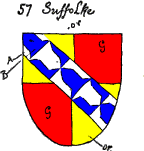 |
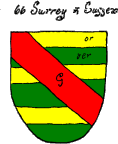 |
| SAKEVILLE. | POYNINGS. |
Andreio de SAKEVILLE, quarterly or and G., a bend verry.Tricorporated: having three bodies, e.g. of a Lion, q.v.
Michaell de POYNINGS, barry 6 or and vert, a bend gules.
Argent, a fesse between three tridents sable--RUSSELL.
Gyronny of eight argent and azure, an eagle displayed erminois; on a chief wavy ermine a trident or surmounting in saltire a flagstaff proper, thereon hoisted a pennant gules, both passing through a chaplet of laurel vert--NICOLAS, Cornwall, granted 1816.
Azure, on a lion rampant argent, holding in the dexter paw a trident or, a key in pale of the field--OCHTERLONY, certified 1779.
Per chevron embattled or and gules, in base two battle-axes in saltire argent; on a chief azure, parted from the field by a fillet wavy, a demi-lion rampant naissant of the third holding in both paws a trident of the first--DYCE.
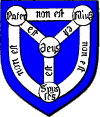 |
| CHRIST CHURCH, London. |
Azure, a representation of the Trinity argent, inscribed sable--CHRIST CHURCH, London.Triparted, or triple-parted. See Cross, §8.
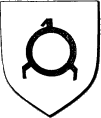 |
| TRYVETT. |
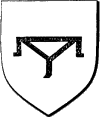 |
| BARCLAY. |
Argent, a round trivet sable--TRYVETT, Somerset.Trois-deux-un, (fr.): three, two, and one. See Blazon.
Argent, a triangular trivet sable--BARCLAY, Devon.
Argent, a trivet within a bordure engrailed sable--John TRYVETT.
Argent, a chevron gules between three trivets azure--BASKERVILL.
Argent, three bars sable, in chief as many trivets of the last--REVETT, co. Cambridge.
 |
| Trowel. |
 |
| Trumpet. |
Sire Giles de TROMPINTONE, de azure crusule de or a ij trompes de or--Roll, temp. ED. II.
Monsire de TRUMPENTON, port d'asure a deux trumpes d'or[et] croisèle or--Roll, temp. ED. III.
Azure, two trumpets in pile between twelve crosses crosslet or--TRUMPINGTON. [From the ancient brass to Roger Trumpington. ob. 1289, in Trumpington Church, Cambridgeshire.]
Sire James de NEYVILE, de goules, crusule de or a ij trompes de or--Roll, temp. ED. II.
Monsire James de NEVILL, port gules a deux trumpes d'or[et] croisele or--Roll, temp. ED. III.
Argent, a chevron engrailed between three trumpets barwise sable--THUNDER, Ireland, 1619.
Or, a cock mounted on a trumpet sable--HODDING.
Azure, semy of trefoils two trumpets in pale or garnished gules--WADRIEPONT.
 |
| Hautboy. |
Azure, three hautboys, wide ends downwards, two and one, between as many crosses crosslet or--BOURDEN.Truncated, applied to a Tree, or parts thereof, when couped.
Gules, two hautboys in saltire between four crosses crosslet or--NEVELL, Sussex.
Argent, a horse(bay colour) passant, holding in his mouth a tulip slipped proper--ATHERTON.
 |
| Tun. |
Sable, a chevron between three tuns barwise argent, [sometimes erroneously given as Argent, a chevron between three barrels sable]--The VINTNERS' Company, London; granted 1442.Tunique: the Surcoat, or Tabard of King of Arms, called so in distinction from that worn by a Herald or Pursuivant.
Gules, on a chevron argent between three pairs of barley garbs in saltire or, as many tuns sable hooped of the third--BREWERS' Company, incorporated 1438; arms granted 1468, confirmed 1560. [On a brass in All Hallows, Barking.] The same arms are borne by the Company of BREWERS, Exeter.
Barry of five argent and azure; on a canton of the second a tun or--KNIGHTON, co. Hertford.
Argent, on a fesse azure between three crosses crosslet fitchy sable, two tuns or--CROXTON, co. Chester.
... three hogsheads, two and one ... --Adam de ORLETON, Bishop of Hereford, 1317-27; Worcester, 1328; and Winchester, 1334-45. [From carving on gatehouse at Esher.]
Gules, three barrels in pale argent--MATON.
Argent, a chevron gules between three barrels[or tuns] standing on their bottoms sable, hooped or--NORTON.
Argent, three tubs gules--BRICKMAN.
 |
| TURBUTT. |
 |
| SOLE. |
 |
| Crest of LAWRENCE. |
Azure, three turbots argent, two and one, joined or--TURBUTT, Ogston Hall, co. Derby; [same borne by TURBUTT, co. York; three turbots naiant proper by TARBUTT of Scotland, and three turbots fretted by TARBUTT of Middlesex].With the above must be grouped the flounder, or flook, as it is called in Scotland, which is probably not to be distinguished from them. Mr.Moule also finds that at Yarmouth this fish is called a butt; in Cornwall he has found the local name to be the carter fish, hence he concludes that the fish borne respectively in the arms of BUTTS and CARTER are meant for a fish of this kind. What the bret fish is, or the birt, he does not seem to have determined. The following examples are taken from his work.
Argent, a chevron gules between three soles haurient[proper] within a bordure engrailed gules--SOLE, Bobbing Place, Kent; also SOLES, Brabanne, co. Cambridge.
Gules, three solefish argent--John de SOLES, Kent.
Vert, a chevron between three soles naiant--SOLEY, Shropshire.
Per pale or and gules, a chevron counterchanged between three soles azure and argent--SOLEY, Worcestershire.
A demi-turbot erect tail upwards is the crest of the family of LAWRENCE, [and so borne by Sir Thomas Lawrence, the celebrated painter].
Argent, a saltire gules between four ermine spots; on a chief of the second three butt fish haurient of the first--BUTTS, Dorking.Turk's head. See Head.
Gules, three flooks(or flounders) argent--ARBUTT.
Sable, a flook argent--FISHER.
Sable, a chevron ermine between three carter fish haurient argent--CARTER, London.
Azure, three brets naiant--BRETCOCK.
Azure, a birt fish proper--BIRT.
Argent, a chevron chequy azure and vert between three turkeys proper--WIKES, co. Devon.Turnip: only one family seems to bear this. Randal Holmes gives the word wisalls(? wurtzels), as meaning the green tops of this or some similar roots.
Argent, a chevron sable between three turkey-cocks in their pride proper--YEO, co. Devon.
Sable, a turnip leaved proper; a chief or, goutty de poix--DAMMANT.Turnpike. See Turnstile; also Gate.
 |
| 1 and 2.Turnstiles. |
Argent, three turnpikes[elsewhere blazoned turnstiles or reels] sable--WOOLSTON. White.
A turnpike or, on a wreath argent and gules--Crest of SKIPWORTH, Linc. (Bart. 1622). Fig. 3.
 |
| 3.Turnspike. |
Argent, a saltire between a cross-gate in chief and another in base and a crescent in each flank gules--HEGENS, Scotland.Turret. See Tower.